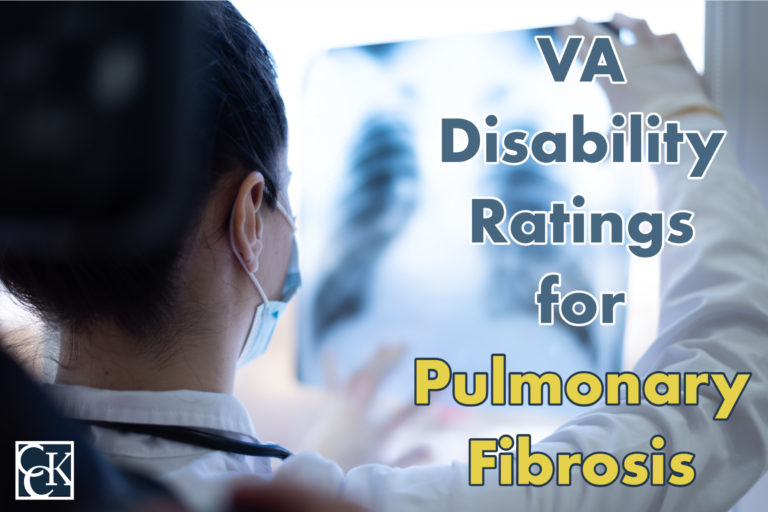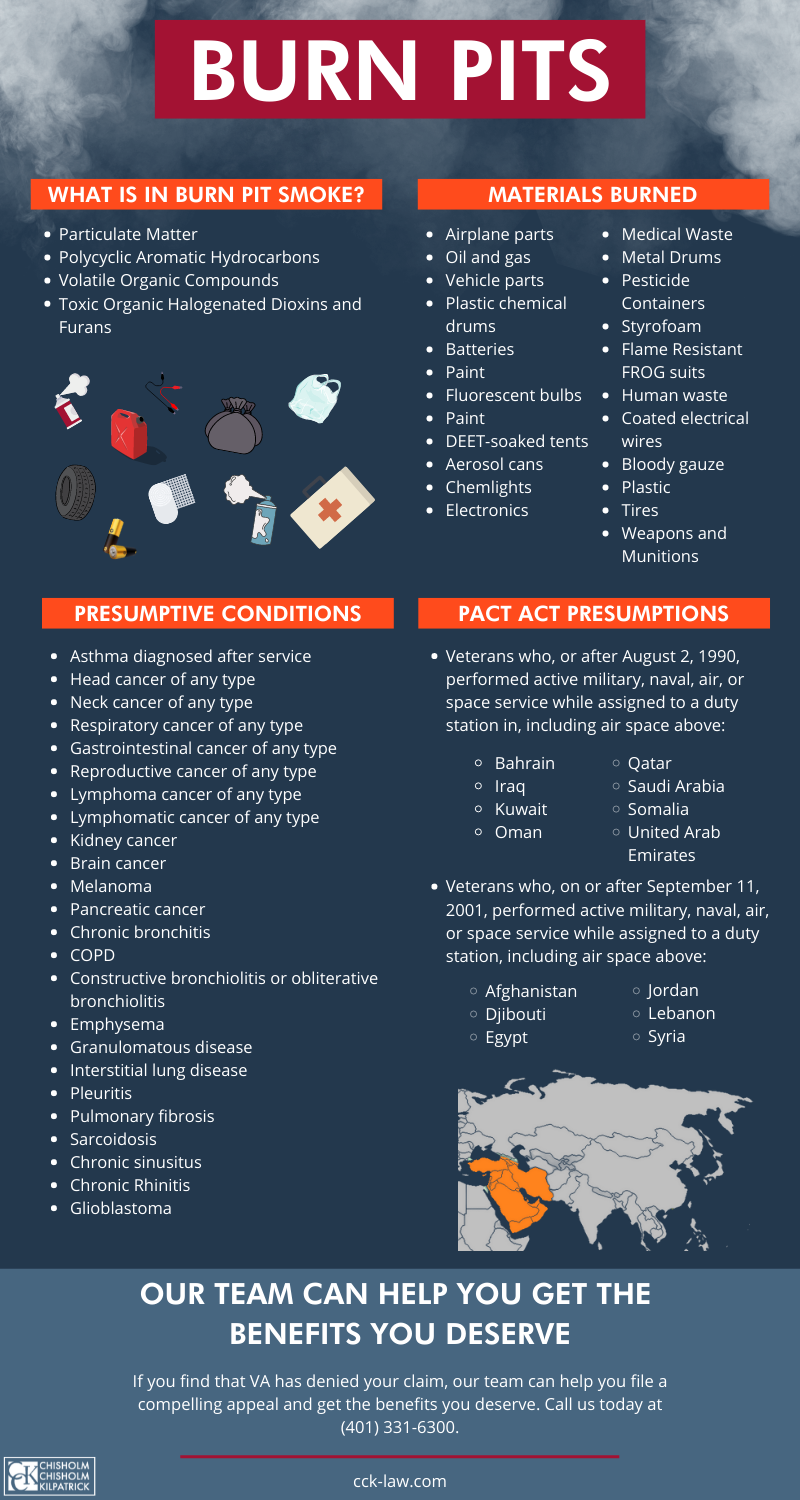VA Disability Ratings for Pulmonary Fibrosis

CCK Law: Our Vital Role in Veterans Law
Pulmonary fibrosis is a form of lung disease which occurs when lung tissue is damaged and scarred. If your service caused or contributed to pulmonary fibrosis, then you may be eligible for VA disability benefits.
What is Pulmonary Fibrosis?
As mentioned above, pulmonary fibrosis is lung disease which occurs if a person has damage to their lung tissue. The damage can make the tissue stiff and thickened, which in turn makes it more difficult for the lungs to function properly. This damage cannot be repaired.
Symptoms
- Shortness of breath
- Excessive mucus
- Fatigue
- Coughing
- Weight loss
- Sore or aching muscles and joints
- Clubbing of fingers or toes
Causes
Certain occupational and environmental factors, and certain medications and medical conditions, can cause pulmonary fibrosis.
Breathing in certain toxins can damage the lungs and lung tissue, leading to pulmonary fibrosis. This can include exposure to asbestos, coal dust, grain dust, hard metal dust, and more.
Certain heart medications, antibiotics, chemotherapy drugs, and anti-inflammatory drugs can also damage the lung tissue, leading to pulmonary fibrosis.
Medical Conditions that Can Cause Lung Damage
- Rheumatoid arthritis
- Sarcoidosis
- Pneumonia
- Sjogren’s syndrome
- Gastroesophageal Reflux Disease (GERD)
- Bluish skin or grey skin, specifically around the eyes or mouth
- Clubbing of fingertips or toes
Diagnosing Pulmonary Fibrosis
Doctors will usually need to perform certain tests to diagnose a person with pulmonary fibrosis. These tests can include:
- Blood tests
- Imaging tests
- Breathing tests
- Oxygen desaturation study
- Biopsy
VA Service Connection for Pulmonary Fibrosis
Veterans who experience pulmonary fibrosis as a result of their military service can apply for service connection to receive disability benefits for their condition. To do this, the veteran needs to fill out and submit VA Form 21-526EZ to VA.
In addition to this, the veteran will need to provide evidence of the following:
- A diagnosis of the service-related condition; AND
- An in-service event, illness, or stressor that caused or contributed to the condition; AND
- A nexus which links the veteran’s condition to their in-service stressor.
Secondary Service Connection
Secondary service connection is a form of service connection for conditions caused or aggravated by other service-connected conditions.
As pulmonary fibrosis is often caused by other medical conditions, veterans can establish service connection on a secondary basis. For example, if a veteran is service connected for rheumatoid arthritis and later develops pulmonary fibrosis as a result, they can receive service connection for pulmonary fibrosis as secondary to rheumatoid arthritis.
PACT Act: Presumptive Service Connection for Pulmonary Fibrosis
Recently, the Honoring Our PACT Act has created a presumption of service connection for veterans who developed pulmonary fibrosis as a result of their service. This means that if a veteran is considered a “covered veteran” and has a diagnosis of pulmonary fibrosis, VA will presume service connection. A covered veteran is one who served:
- On or after August 2, 1990, with active military, naval, air, or space service while assigned to a duty station, including the airspace above:
- Bahrain
- Iraq
- Kuwait
- Oman
- Qatar
- Saudi Arabia
- Somalia
- United States Emirates
- On or after September 11, 2001, with active military, naval, air, or space service while assigned to a duty station, including the airspace above:
- Afghanistan
- Djibouti
- Eqypt
- Jordan
- Lebanon
- Syria
- Yemen
- Uzbekistan
VA presumes service connection for veterans who served in these locations and time periods because of likely exposure to military burn pits. Burn pits are large pits that were used by the U.S. Military to dispose of waste in the post-9/11 era. Waste such as plastics, rubber, petroleum, medical waste, human waste, and more were burned in these pits.
Although burn pits were effective in reducing waste, the practice created large plumes of toxic smoke which was problematic in places such as the Middle East, as the desert wind carried the smoke for miles.

Compensation and Pension (C&P) Exams for Pulmonary Fibrosis
Compensation and pension exams, or C&P exams, are exams VA may request to evaluate a veteran’s service-related condition. VA uses these exams to gather more evidence in order to determine if service connection is warranted and to assign disability ratings. C&P exams are usually performed by a VA examiner or a VA-contracted examiner.
Prior to the exam, the examiner will typically have reviewed the veteran’s file to be familiar with their case. The examiner may ask questions about the veteran’s service or their condition. For example, if the veteran’s condition is linked to burn pit exposure, they may ask questions about where and when they were exposed.
The examiner may also perform tests to better understand how a veteran’s lungs are functioning. These tests may include:
- Forced Vital Capacity (FVC)
- Forced Expiratory Volume in 1 Second (FEV1)
- Diffusion Capacity for Carbon Monoxide by the Single Breath Method (DLCO(SB))
- Exercise Testing
Generally, pulmonary function tests are designed to show how well the lungs are functioning and can measure lung volume, capacity, rates of flow, and gas exchange. These tests can also measure three specific aspects of lung function:
- Spirometry
- Lung Volumes
- Diffusion capacity in the lungs
Often, the results of the tests can be used to determine what disability rating, if any, a veteran will receive.

VA Disability Ratings for Pulmonary Fibrosis
There are several different Diagnostic Codes listed in 38 CFR § 4.97, Schedule of ratings for Respiratory System, that relate to pulmonary fibrosis.
- Diagnostic Code 6829 – Drug-induced pulmonary pneumonitis and fibrosis
- Diagnostic Code 6830 – Radiation-induced pulmonary pneumonitis and fibrosis
The rating criteria categorizes these forms of pulmonary fibrosis as Interstitial Lung Disease. The criteria are listed below:
- 100%
- FEV-1 less than 50 percent of predicted value; OR
- Diffusion Capacity of the Lung for Carbon Monoxide by the Single Breath Method (DLCO(SB)) less than 40 percent predicted; OR
- Maximum exercise capacity less than 15 ml/kg/min oxygen consumption with cardiorespiratory limitation; OR
- Cor pulmonale; OR
- Pulmonary hypertension; OR
- Requires outpatient oxygen therapy.
- 60%
- FVC of 50 to 64 percent; OR
- DLCO(SB) of 40 to 55 percent predicted; OR
- Maximum exercise capacity of 15 to 20 ml/kg/min oxygen consumption with cardiorespiratory limitation.
- 30%
- FVC of 65 to 74 percent predicted; OR
- DLCO(SB) of 56 to 65 percent predicted.
- 10%
- FVC of 75 to 80 percent predicted; OR
- DLCO(SB) of 66 to 80 percent.
How CCK Can Help You Appeal for VA Disability Benefits
If you are a veteran appealing a VA decision, the experienced veterans’ advocates at Chisholm Chisholm & Kilpatrick may be able to help. Our team can help gather evidence and craft persuasive arguments to support your case. If you need an accredited representative to help you, call our office today.
About the Author
Share this Post
